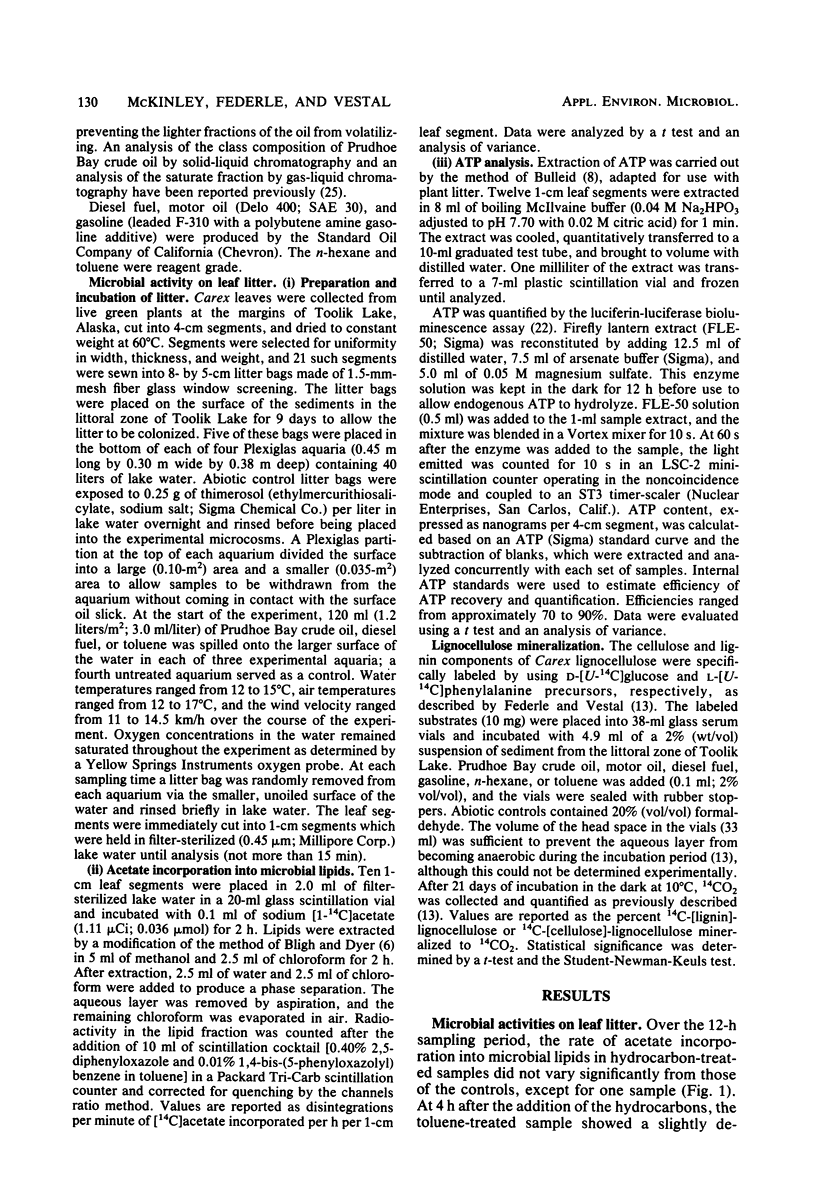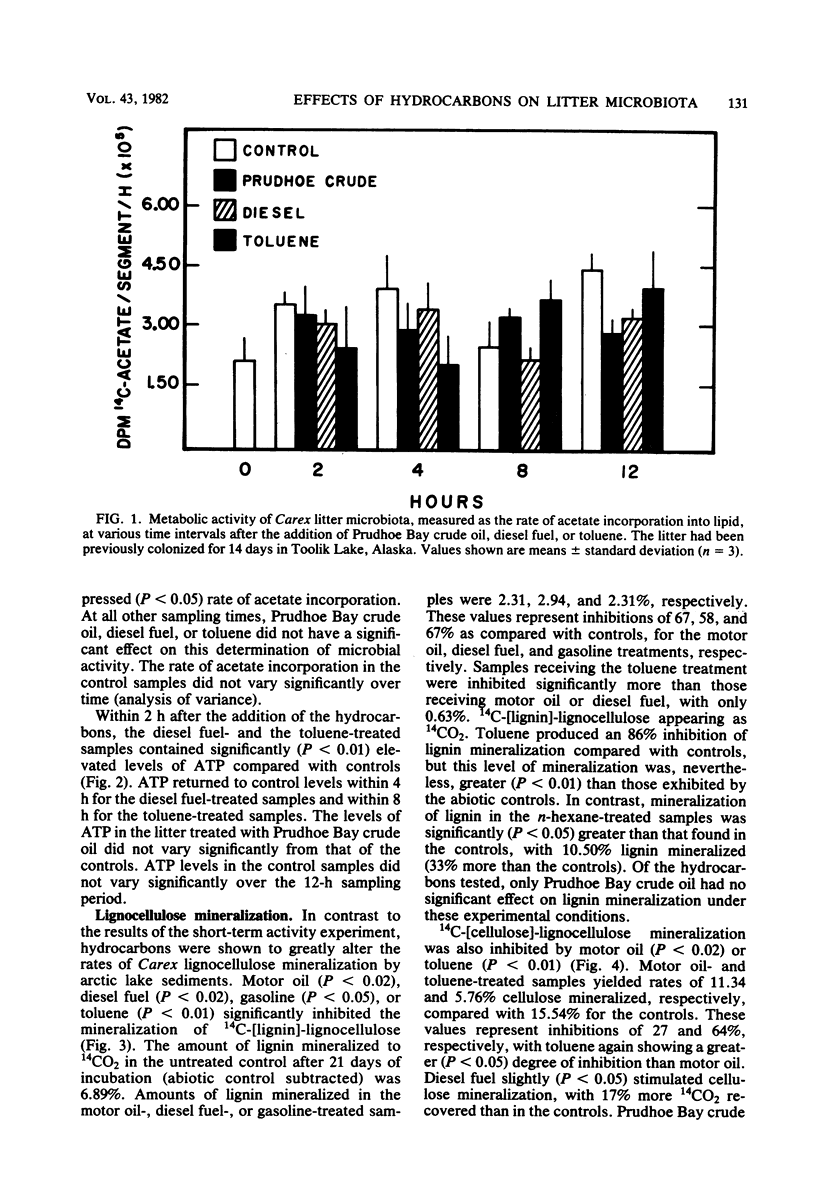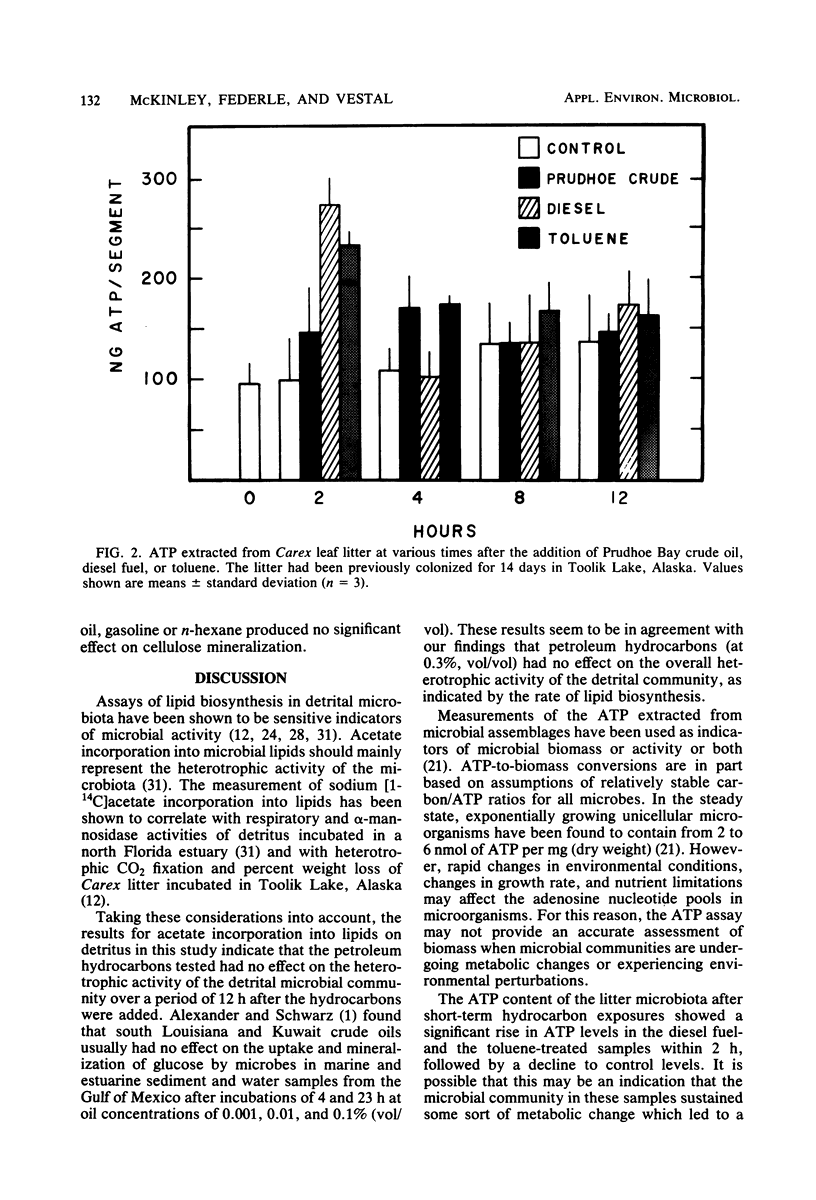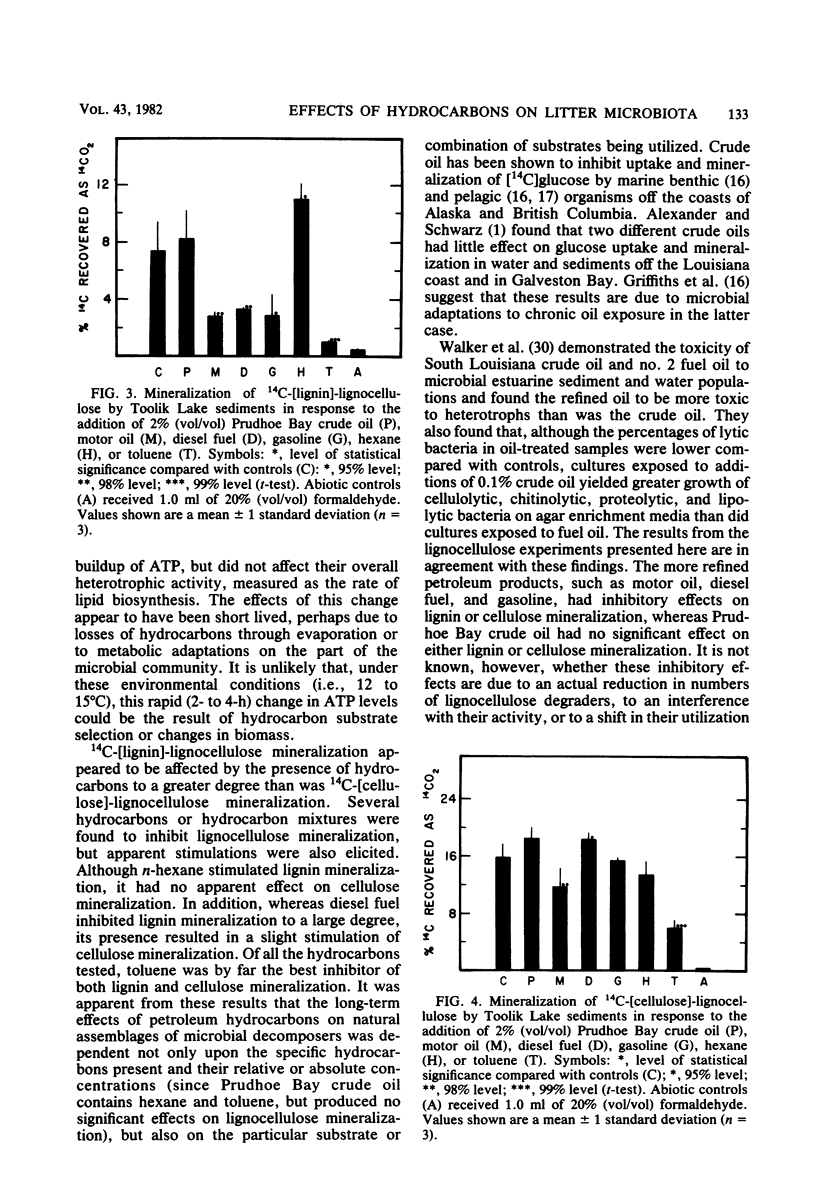Abstract
The effects of petroleum hydrocarbons on the microbial community associated with decomposing Carex leaf litter colonized in Toolik Lake, Alaska, were examined. Microbial metabolic activity, measured as the rate of acetate incorporation into lipid, did not vary significantly from controls over a 12-h period after exposure of colonized Carex litter to 3.0 ml of Prudhoe Bay crude oil, diesel fuel, or toluene per liter. ATP levels of the microbiota became elevated within 2 h after the exposure of the litter to diesel fuel or toluene, but returned to control levels within 4 to 8 h. ATP levels of samples exposed to Prudhoe Bay crude oil did not vary from control levels. Mineralization of specifically labeled 14C-[lignin]-lignocellulose and 14C-[cellulose]-lignocellulose by Toolik Lake sediments, after the addition of 2% (vol/vol) Prudhoe Bay crude oil, motor oil, diesel fuel, gasoline, n-hexane, or toluene, was examined after 21 days of incubation at 10°C. Diesel fuel, motor oil, gasoline, and toluene inhibited 14C-[lignin]-lignocellulose mineralization by 58, 67, 67, and 86%, respectively. Hexane-treated samples displayed an increase in the rate of 14C-[lignin]-lignocellulose mineralization of 33%. 14C-[cellulose]-lignocellulose mineralization was inhibited by the addition of motor oil or toluene by 27 and 64%, respectively, whereas diesel fuel-treated samples showed a 17% increase in mineralization rate. Mineralization of the labeled lignin component of lignocellulose appeared to be more sensitive to hydrocarbon perturbations than was the labeled cellulose component.
Full text
PDF






Selected References
These references are in PubMed. This may not be the complete list of references from this article.
- Alexander S. K., Schwarz J. R. Short-term effects of South louisiana and kuwait crude oils on glucose utilization by marine bacterial populations. Appl Environ Microbiol. 1980 Aug;40(2):341–345. doi: 10.1128/aem.40.2.341-345.1980. [DOI] [PMC free article] [PubMed] [Google Scholar]
- Atlas R. M. Microbial degradation of petroleum hydrocarbons: an environmental perspective. Microbiol Rev. 1981 Mar;45(1):180–209. doi: 10.1128/mr.45.1.180-209.1981. [DOI] [PMC free article] [PubMed] [Google Scholar]
- BLIGH E. G., DYER W. J. A rapid method of total lipid extraction and purification. Can J Biochem Physiol. 1959 Aug;37(8):911–917. doi: 10.1139/o59-099. [DOI] [PubMed] [Google Scholar]
- Bartha R. The microbiology of aquatic oil spills. Adv Appl Microbiol. 1977;22:225–266. doi: 10.1016/s0065-2164(08)70164-3. [DOI] [PubMed] [Google Scholar]
- Blumer M., Sass J. Oil pollution: persistence and degradation of spilled fuel oil. Science. 1972 Jun 9;176(4039):1120–1122. doi: 10.1126/science.176.4039.1120. [DOI] [PubMed] [Google Scholar]
- Calder J. A., Lader J. H. Effect of dissolved aromatic hydrocarbons on the growth of marine bacteria in batch culture. Appl Environ Microbiol. 1976 Jul;32(1):95–101. doi: 10.1128/aem.32.1.95-101.1976. [DOI] [PMC free article] [PubMed] [Google Scholar]
- Federle T. W., Vestal J. R. Lignocellulose mineralization by arctic lake sediments in response to nutrient manipulation. Appl Environ Microbiol. 1980 Jul;40(1):32–39. doi: 10.1128/aem.40.1.32-39.1980. [DOI] [PMC free article] [PubMed] [Google Scholar]
- Federle T. W., Vestal J. R. Microbial colonization and decomposition of carex litter in an arctic lake. Appl Environ Microbiol. 1980 Apr;39(4):888–893. doi: 10.1128/aem.39.4.888-893.1980. [DOI] [PMC free article] [PubMed] [Google Scholar]
- Griffin L. F., Calder J. A. Toxic effect of water-soluble fractions of crude, refined, and weathered oils on the growth of a marine bacterium. Appl Environ Microbiol. 1977 May;33(5):1092–1096. doi: 10.1128/aem.33.5.1092-1096.1977. [DOI] [PMC free article] [PubMed] [Google Scholar]
- Griffiths R. P., McNamara T. M., Caldwell B. A., Morita R. Y. Field observations on the acute effect of crude oil on glucose and glutamate uptake in samples collected from arctic and subarctic waters. Appl Environ Microbiol. 1981 Jun;41(6):1400–1406. doi: 10.1128/aem.41.6.1400-1406.1981. [DOI] [PMC free article] [PubMed] [Google Scholar]
- Gutnick D. L., Rosenberg E. Oil tankers and pollution: a microbiological approach. Annu Rev Microbiol. 1977;31:379–396. doi: 10.1146/annurev.mi.31.100177.002115. [DOI] [PubMed] [Google Scholar]
- Horowitz A., Atlas R. M. Response of microorganisms to an accidental gasoline spillage in an arctic freshwater ecosystem. Appl Environ Microbiol. 1977 Jun;33(6):1252–1258. doi: 10.1128/aem.33.6.1252-1258.1977. [DOI] [PMC free article] [PubMed] [Google Scholar]
- Karl D. M. Cellular nucleotide measurements and applications in microbial ecology. Microbiol Rev. 1980 Dec;44(4):739–796. doi: 10.1128/mr.44.4.739-796.1980. [DOI] [PMC free article] [PubMed] [Google Scholar]
- King J. D., White D. C., Taylor C. W. Use of lipid composition and metabolism to examine structure and activity of estuarine detrital microflora. Appl Environ Microbiol. 1977 May;33(5):1177–1183. doi: 10.1128/aem.33.5.1177-1183.1977. [DOI] [PMC free article] [PubMed] [Google Scholar]
- Wyndham R. C., Costerton J. W. Heterotrophic potentials and hydrocarbon biodegradation potentials of sediment microorganisms within the athabasca oil sands deposit. Appl Environ Microbiol. 1981 Mar;41(3):783–790. doi: 10.1128/aem.41.3.783-790.1981. [DOI] [PMC free article] [PubMed] [Google Scholar]


